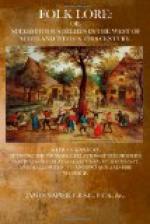but so far as traces do remain, they appear to indicate
that it was celebrated much after the same manner as
the Scottish Celts are said to have celebrated Beltane.
Indeed, the Celtic Irish hold their Beilteme
feast on the 21st June, and their fires are kindled
on the tops of hills, and each member of a family is,
in order to secure good luck, obliged to pass through
the fire. On this occasion also, a feast is held.
A similar practice was common in West Cornwall at
midsummer. Fires were kindled, and the people
danced round them, and leaped singly through the flames
to ensure good luck and protection against witchcraft.
The following passage occurs in Traditions and
Hearthside Stories of West Cornwall, by William
Bottreill, 1873:—“Many years ago,
on Midsummer eve, when it became dusk, very old people
in the west country would hobble away to some high
ground whence they obtained a view of the most prominent
high hill, such as Bartinney-Chapel, Cambrae, Sancras
Bickan, Castle-au-dinas, Cam-Gulver, St. Agnes-Bickan,
and many other beacon hills far away to the north and
east which vied with each other in their midsummer
night blaze. They counted the fires, and drew
a presage from the number of them. There are now
but few bonfires to be seen on the western heights;
yet we have observed that Tregonan, Godolphin, and
Carnwath hills, with others far away towards Redruth,
still retain their Baal fires. We would gladly
go many miles to see the weird-looking, yet picturesque
dancers around the flames, on a cairn or high hill
top, as we have seen them some forty years ago.”
The ancient Egyptians had their midsummer feasts,
as also had the Greeks and Romans. During these
festivals, we are told that the people, headed by
the priests, walked in procession, carrying flowers
and other emblems of the season in honour of their
gods. Such processions were continued during
the early years of the Christian Church, and the Christian
priests in their vestments went into the fields to
ask a blessing on the agricultural produce of the
year. Towards the beginning of the twelfth century
the Church introduced the Feast of God, and
fixed the 19th June for its celebration. The
eucharistic elements were declared to be the actual
presence of God, and this, the consecrated Host or
God himself was carried through the open streets by
a procession of priests, the people turning out to
do it honour, kneeling and worshipping as it passed.
This feast of God may have absorbed some of the ancient
midsummer practices, but the Feast of St. John’s
Day, which is held upon the 24th June, has in
its customs a greater similarity to the ancient sun
feast. On the eve of St. John’s day, people
went to the woods and brought home branches of trees,
which they fixed over their doorways. Towards
night of St. John’s Day, bonfires were kindled,
and round them the people danced with frantic mirth,
and men and boys leaped through the flames. Leaping
through the flames is a common practice at these survivals
of sun festivals, and although done now, partly for
luck and partly for sport, there can be little doubt
but that originally human sacrifices were then offered
to the sun god.




